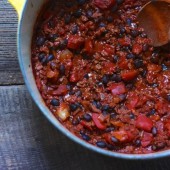Can we talk about soup? Old man winter has overstayed his welcome; the only benefit being that we have carte blanche to continue those stewing, braising and baking activities that have kept us busy all winter.
I’ve seen the restaurants waving their bundles spring vegetables in the air chanting “we have ramps!” My answer: too soon! I’m not ready for ramps, or fiddleheads, or even asparagus. If it’s below freezing, I don’t want to see any of those tender shoots. What good does it do me to devour a lightly dressed spring salad when I’m wearing two sweaters and a pair of mocs?
Back to that soup. I’ve waxed poetic on this blog about my days as a ski racer, growing up on Canadian slopes from the mountains of BC, to the Laurentians of Quebec. Our home base was Ontario, so we spent the bulk of our time racing in Quebec.
Our trips happened frequently throughout the winter months. In the hours before dawn, we’d load our skis and poles into storage boxes built on top of our vans and start our slow trek East. My preference was to ride in the red van that we fondly referred to as The Big Cheese. It had modern day conveniences, notably a reliable radio station and a functioning heater.
The Big Cheese was named after our head ski coach, a man by the name of Jurg Gfeller, a former skier on the National Swiss Team who’d started our school in tiny Collingwood, Ontario.
Rodney had the chance to meet Jurg last year when for the first time in 20 years, I returned to Collingwood for a friend’s wedding. We stopped by the Ski Academy so that I could show Rodney a little of my roots including the dorm room where I’d ingest late night brownies and the words to every Indigo Girls song.
As luck would have it, Jurg was at the house that day, just as I’d left him 20 years before. Despite a lack of ski conditions (this was October), he was dressed for the season in a snug Descente vest.
He gave me a teasing but hard punch on the shoulder: “Vee gonna get you out on da slopes dis year Jesseeca?”
I was too ashamed to admit that I’d only been on skis a handful of times since I’d quit the sport in 2000.
“That’s the plan” I responded. I then launched into a lengthy description of my present-day nightmares, which are entirely skiing-related. Skis that won’t carve a turn; a pole dropped from the chairlift right before my start, and the most frightening of all: slipping off the chairlift and spending the remainder of the ride clutching the base for dear life.
Rodney shot me a look that suggested that I was barreling out of control into my gray zone of unproductive tangents. I’m working on it. No stranger needs to learn about my insomnia, and Jurg certainly didn’t need to know that my days as a skier under his tutelage contributed to some sort of athletics-related PTSD.
There were fond memories too. Yes, the trips were long; 8 hours in a crowded van to get us to Mont Tremblant or Mont Sainte-Anne – with limited stops for food. But when we did stop, if it wasn’t a hit & run at a roadside McDonald’s, it was real food. French food.
Anticipation would build as we neared Montreal. The Pirelli Pneus billboard was my signal, answering that crucial “are we there yet?” question. Finally, I could visualize stretching cramped legs and indulging in some stick-to-your ribs Quebecois cooking.
One of my favorite dishes was, soupe a l’oignon au fromage, French onion soup. Onions slowly-cooked in a hearty beef stock, served in a crock with a thick layer of melted Gruyere cheese. Not to be confused with the gimmicky versions you’ll find in nondescript cafeterias, delis and dives. This stuff was the real deal – real beef bones, authentic French cheese.
I don’t think I’ve had soup that good since.
We were experiencing another cold snap last week, and I was digging around my fridge for inspiration. It was Saturday, and I was on a comfort food mission, but lacking a solid plan.
In one of those scenarios presented on cooking competitions, I faced an odd yet promising bag of mystery ingredients: a package of Sunday bacon, some collard greens, an onion, canned tomatoes, a sack of dried chickpeas. Minestrone? The wheels were turning.
As it was early in the day, I figured I’d put my slow cooker to work so that I could lazily attend to other things, namely lying flat on the couch, coffee in hand, dog curled and wedged into my crotch.
13 comments



















